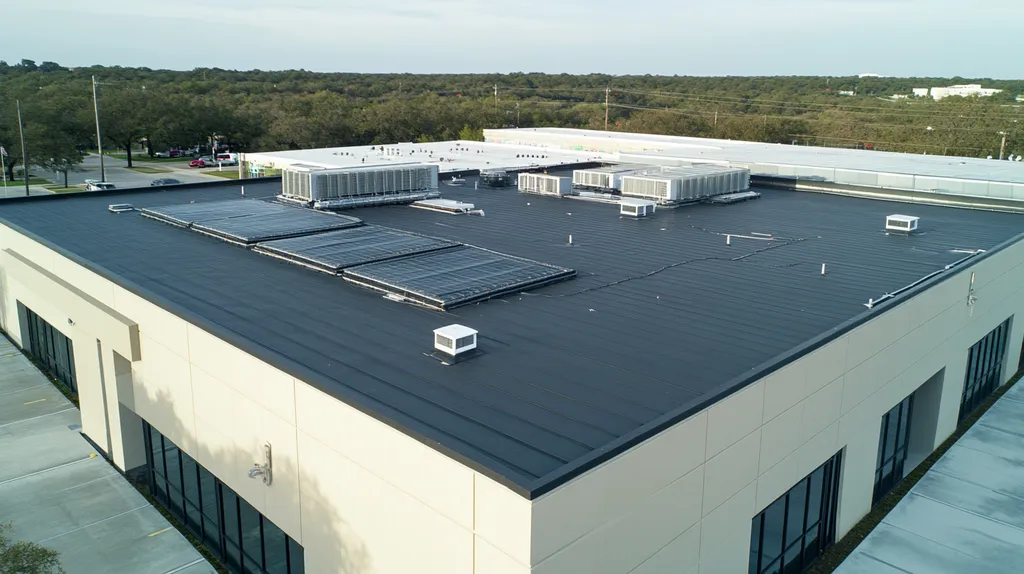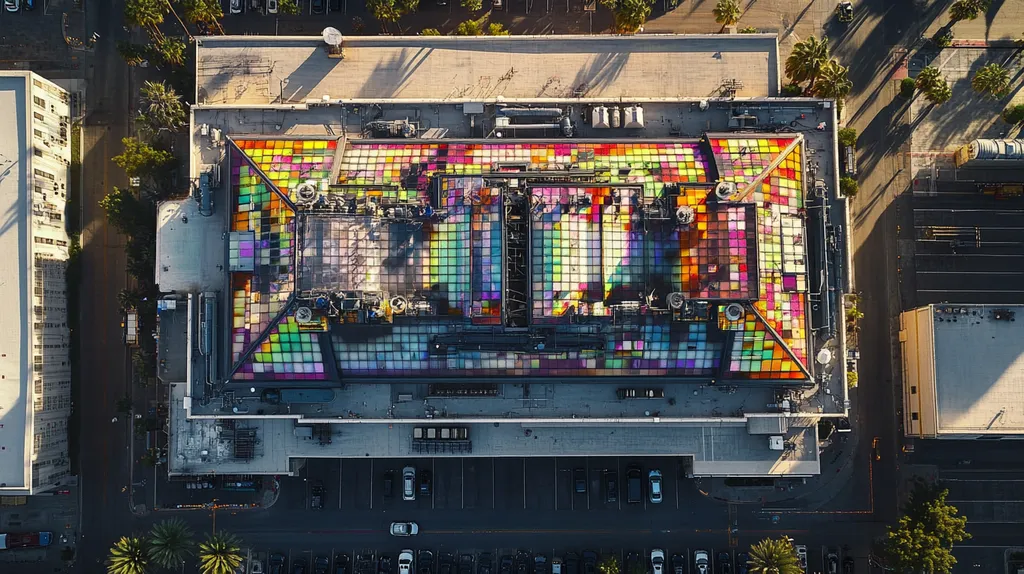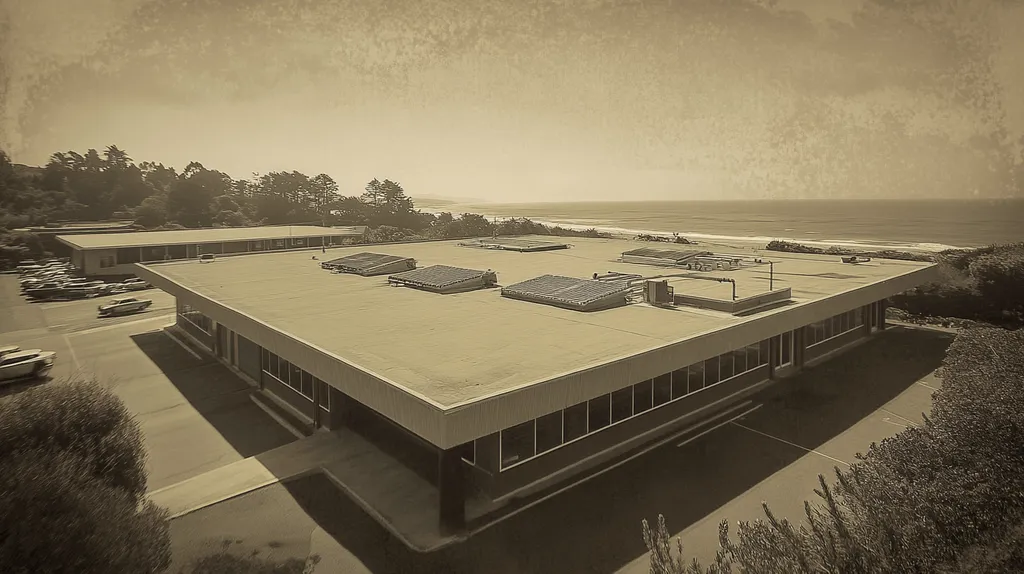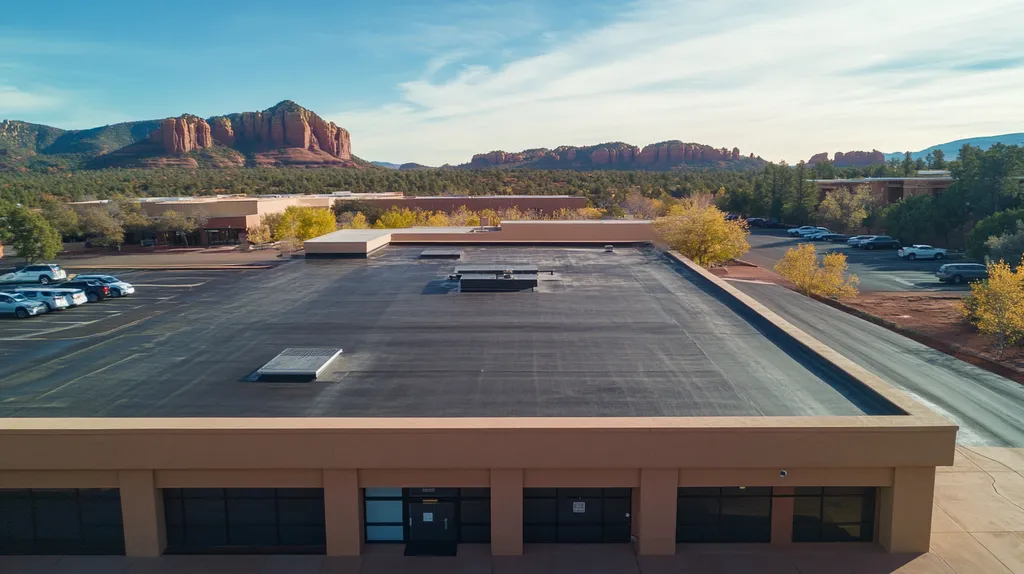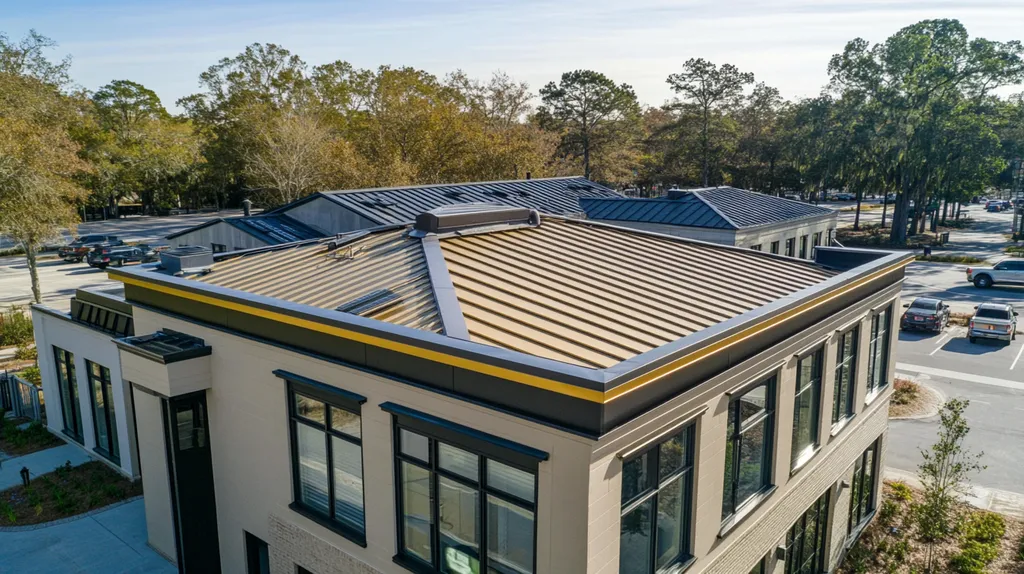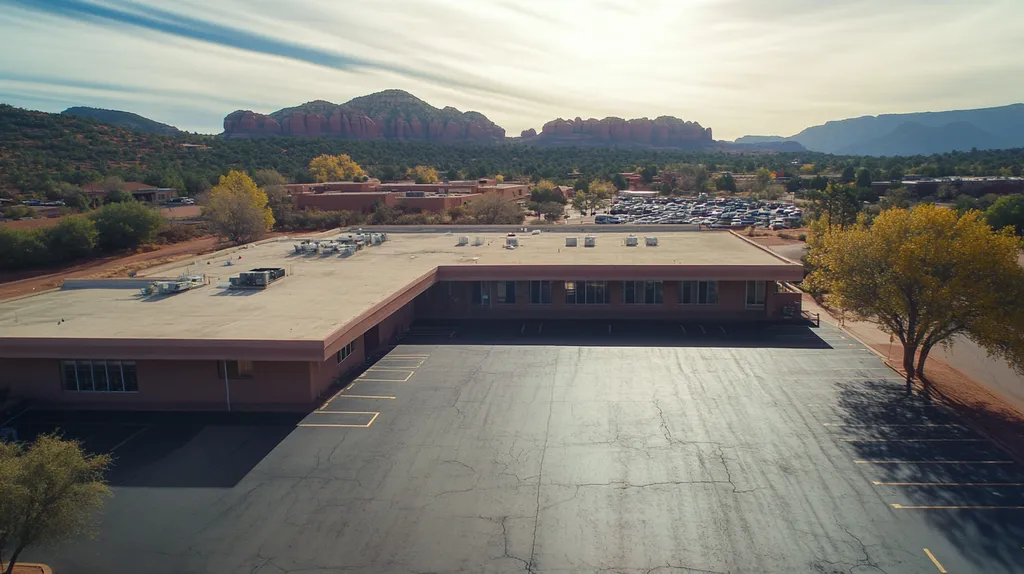The industrial roofing sector faces an unprecedented environmental challenge, with commercial buildings generating nearly 40% of America’s carbon emissions. Traditional roofing materials and methods contribute significantly to this environmental impact while driving up energy costs.
Forward-thinking facility managers are discovering that eco-friendly roofing solutions offer both environmental benefits and substantial cost savings. Modern sustainable options, from vegetative green roofs to recycled materials, can reduce cooling costs by up to 25% while extending roof lifespan.
This comprehensive guide examines the key elements of sustainable industrial roofing, from material selection to long-term performance factors, helping facility managers make informed decisions that benefit both their buildings and the environment.
SECTION 1: THE BASICS EXPLAINED
The industrial roofing sector stands at a critical crossroads as environmental concerns reshape building requirements. Studies show commercial buildings generate nearly 40% of America’s carbon emissions, with roofing systems playing a major role in this impact. Forward-thinking facility managers are discovering that eco-friendly roofing solutions offer both environmental benefits and substantial cost savings through reduced energy consumption and extended service life.
What It Is (In Plain Language)
Eco-friendly roofing encompasses systems and materials specifically engineered to reduce environmental impact while enhancing building performance. These solutions include vegetative green roofs that support plant life, highly reflective surfaces that minimize heat absorption, and recycled materials that divert waste from landfills.
Sustainable commercial roofing materials, such as green roofs, solar panels, metal roofs, and recycled shingles, improve building performance while lowering carbon footprint. These materials work together to create comprehensive roofing systems that protect facilities while supporting environmental goals. (source: Nations Roof)
Modern eco-friendly roofing also incorporates advanced technologies like integrated solar panels and rainwater collection systems. These additions transform the roof from a passive barrier into an active contributor to building efficiency.
Why It Matters (To Your Building)
The impact of eco-friendly roofing extends far beyond environmental benefits. These systems directly affect your facility’s bottom line through reduced heating and cooling costs, decreased maintenance requirements, and extended roof lifespan.
Many regions now offer tax incentives and rebates for implementing sustainable roofing solutions. These financial benefits, combined with ongoing energy savings, can significantly reduce the total cost of ownership.
Property values also benefit from eco-friendly roofing installations. Buildings with sustainable features increasingly command higher rents and attract quality tenants who prioritize environmental responsibility.
How It Works
Eco-friendly roofing systems employ multiple mechanisms to enhance building performance. Reflective surfaces bounce solar radiation away from the building, while insulating layers prevent heat transfer between the interior and exterior.
Green roof systems use plant cover to absorb rainfall, reducing stormwater runoff and providing natural cooling. The soil and vegetation layers act as natural insulators, moderating indoor temperatures year-round.
Integrated technologies like solar panels convert unused roof space into power generation stations. Meanwhile, rainwater harvesting systems capture precipitation for non-potable uses, reducing demand on municipal water supplies.
SECTION 2: PRACTICAL APPLICATIONS
The evolution of industrial roofing has reached a critical turning point as environmental concerns intersect with operational efficiency. Traditional roofing systems contribute significantly to urban heat islands and energy waste, while modern eco-friendly alternatives offer proven solutions. Understanding the practical applications of sustainable roofing helps facility managers make informed decisions that balance environmental responsibility with operational requirements.
Common Uses & Examples
Reflective roofing systems have become standard in large industrial facilities, particularly in sun-exposed regions. These materials reflect up to 80% of solar radiation, dramatically reducing cooling demands and urban heat island effects.
Recycled shingles and rubber roofing materials made from reclaimed tires offer exceptional durability with lifespans exceeding 50 years. These materials not only reduce landfill waste but also provide superior storm resistance and longevity. (source: Smart Cities Dive)
Vegetative roof systems excel in urban environments where stormwater management is crucial. These installations can retain up to 70% of rainfall, reducing runoff while providing natural insulation.
Solar-ready roofing designs incorporate mounting points and electrical conduits during installation, simplifying future renewable energy upgrades while maintaining warranty coverage.
When You Need It Most
Facilities approaching roof replacement age present ideal opportunities for sustainable upgrades. The incremental cost difference becomes negligible when factored into scheduled replacement costs.
Buildings in high-energy-cost regions benefit most immediately from eco-friendly installations. These facilities often see ROI acceleration through reduced cooling expenses and local utility incentives.
Urban locations facing strict environmental regulations find particular value in green roofing solutions. These systems help meet stormwater management requirements while providing documented environmental benefits.
Facilities with high cooling loads or substantial roof exposure should prioritize reflective solutions. These properties typically achieve the fastest payback through reduced HVAC strain.
Interactions With Other Systems
Modern building automation systems can optimize performance when integrated with smart roofing components. Sensors monitoring roof temperature and moisture levels enable precise HVAC adjustments.
Structural considerations become crucial when combining multiple sustainable technologies. Engineering assessments ensure the building can support added weight from green roofs or solar installations.
Water management systems benefit from coordinated design with eco-friendly roofing. Proper integration enables efficient collection and distribution of harvested rainwater.
Ventilation systems work more efficiently when paired with sustainable roofing. Reduced heat load through the roof allows for smaller HVAC equipment and lower operating costs.
SECTION 3: KEY TERMINOLOGY DECODED
The complexity of roofing terminology creates significant barriers to implementing sustainable solutions. When facility managers misinterpret technical specifications or industry terms, it can lead to costly installation errors and reduced environmental benefits. Understanding the language of eco-friendly roofing is essential for making informed decisions that deliver both performance and sustainability.
Essential Terms Explained
Eco-friendly roofing encompasses a range of materials and systems that minimize environmental impact while maximizing building performance. Metal roofs reflect solar radiant heat, reducing cooling costs by up to 25%, while recycled shingles made from rubber, plastic, and wood fiber help divert waste from landfills. (source: Refined Roofing TX)
“Green roofs” specifically refer to vegetative systems that support plant life, providing natural insulation and managing stormwater runoff. These living roofs create habitat spaces while reducing urban heat island effects.
“Cool roofs” use highly reflective materials and light colors to minimize heat absorption. This passive cooling approach significantly reduces air conditioning demands during peak summer months.
“Thermal mass” describes materials that absorb and store heat energy, helping regulate indoor temperatures throughout daily heating and cooling cycles.
Industry Jargon Translated
“Solar reflectance index” (SRI) measures a material’s ability to reject solar heat. Higher SRI values indicate better heat reflection, leading to reduced cooling costs and improved comfort.
“Embodied carbon” refers to the total greenhouse gas emissions associated with manufacturing, transporting, and installing roofing materials. Lower embodied carbon indicates reduced environmental impact.
“TPO” and “PVC” are single-ply membrane materials engineered for durability and recyclability. These materials offer excellent weather resistance while supporting end-of-life recycling goals.
“Building envelope” encompasses all exterior building elements, including the roof, that separate conditioned and unconditioned spaces. An efficient envelope reduces energy transfer and improves building performance.
Measurement & Units Simplified
“R-value” measures thermal resistance, indicating how well insulation blocks heat flow. Higher R-values mean better insulation performance, with requirements varying by climate zone.
“Solar absorption” is measured as a percentage, showing how much solar energy a material converts to heat. Lower absorption percentages indicate better cooling performance.
“Load capacity” measures the weight a roof can safely support, typically expressed in pounds per square foot. This becomes crucial when adding green roof systems or solar panels.
“Life-cycle cost” calculates total ownership expenses over time, including installation, maintenance, energy savings, and replacement. This metric helps compare long-term value between different roofing options.
SECTION 4: DECISION FACTORS
Selecting the right eco-friendly roofing system represents a critical infrastructure decision that impacts both environmental footprint and operational costs. Modern sustainable roofing solutions can reduce cooling expenses by up to 25% while supporting broader environmental goals. Understanding the key decision factors helps facility managers navigate the complexities of material selection, performance requirements, and long-term value proposition.
Cost Considerations
Initial investment remains a primary concern when evaluating sustainable roofing options. While eco-friendly systems often carry higher upfront costs, they typically deliver superior returns through energy savings and extended service life.
Metal roofs and other reflective materials can reduce cooling costs by up to 25% through improved solar heat reflection, making them particularly valuable in warm climates. (source: Refined Roofing TX)
Many jurisdictions offer tax incentives, rebates, and financing programs specifically for sustainable roofing installations. These programs can significantly offset initial costs while accelerating return on investment.
Life-cycle cost analysis reveals that sustainable options often outperform traditional materials when accounting for energy savings, maintenance reduction, and extended replacement intervals.
Performance Trade-offs
Different eco-friendly materials excel in specific performance categories. Reflective coatings maximize cooling efficiency but may require periodic renewal, while vegetative systems excel at stormwater management but demand regular maintenance.
Local climate conditions heavily influence material selection. Hot regions benefit most from reflective surfaces, while areas with high rainfall may prioritize water management capabilities.
Installation requirements vary significantly between sustainable options. Some materials demand specialized expertise or specific substrate preparations to achieve optimal performance.
Building use patterns affect system selection. Facilities with high cooling loads benefit most from reflective solutions, while those in urban environments may prioritize stormwater management.
Lifespan & Durability Factors
Material longevity directly impacts sustainability and return on investment. Many eco-friendly options offer extended service lives, reducing replacement frequency and associated costs.
Installation quality significantly affects system performance and durability. Proper installation techniques and attention to detail ensure maximum service life and maintained efficiency.
Regular maintenance requirements vary between sustainable options. Some systems demand minimal upkeep, while others require scheduled care to maintain peak performance.
Environmental resistance capabilities differ among materials. UV stability, weather resistance, and impact tolerance should align with local conditions and facility requirements.
SECTION 5: COMMON CHALLENGES
The transition to eco-friendly roofing brings unique challenges that can undermine both environmental benefits and financial returns. The construction industry accounts for nearly 37% of global carbon emissions, with roofing as a major contributor. Understanding and addressing common pitfalls in sustainable roofing implementation is crucial for maximizing environmental impact while ensuring long-term performance.
Frequent Problems & Solutions
Traditional roofing materials are resource-intensive to produce, involve high energy consumption, and generate considerable waste. In contrast, eco-friendly alternatives like cool roofs, green roofs, and solar shingles improve energy efficiency while reducing environmental impact. (source: Sunbase Data)
Material compatibility issues often arise when integrating different sustainable components. Careful system design and professional installation help ensure all elements work together effectively.
Drainage problems frequently occur in green roof installations, leading to water damage and reduced insulation performance. Proper drainage layer design and regular maintenance prevent these issues.
Weight distribution concerns can compromise structural integrity, particularly with vegetative systems. Professional engineering assessment before installation prevents overloading.
Warning Signs To Watch For
Decreased energy efficiency often signals degrading reflective properties or insulation performance. Regular thermal imaging can detect hot spots and insulation gaps before they impact utility bills.
Ponding water beyond 48 hours indicates drainage problems that can lead to membrane damage and leaks. Quick identification allows for drainage correction before serious damage occurs.
Separation at seams or flashings suggests potential water infiltration points. These areas require immediate attention to prevent system failure.
Plant die-off in vegetative systems may indicate underlying membrane issues or irrigation problems. Regular monitoring helps maintain both aesthetic and functional benefits.
Preventative Approaches
Establishing comprehensive maintenance schedules based on system type and local climate conditions prevents many common issues. This includes regular inspections, cleaning, and preventive repairs.
Training facility staff in basic monitoring and maintenance procedures enables early problem detection. This reduces response time and prevents minor issues from escalating.
Documenting all maintenance activities and system changes creates valuable historical data. This information guides future maintenance decisions and improvements.
Installing monitoring systems that track performance metrics helps identify potential issues before they become visible problems. This proactive approach extends system lifespan while maintaining efficiency.
SECTION 6: NEXT STEPS & RESOURCES
The transition to eco-friendly industrial roofing represents a critical decision point for facility managers. With commercial buildings contributing significantly to carbon emissions, choosing sustainable roofing solutions has become essential for environmental compliance and operational efficiency. Research shows recycled roofing materials now match or exceed the performance of traditional options while dramatically reducing environmental impact.
Questions To Ask Providers
Recycled roofing materials like reclaimed clay, concrete, and metal offer durability comparable to new materials while significantly reducing environmental impact through lower processing energy requirements. (source: Alpha Roofing)
Request detailed material composition information, including recycled content percentages and source verification. Understanding material origins helps ensure genuine sustainability rather than greenwashing.
Verify provider certifications and experience with specific eco-friendly systems. Installation expertise directly impacts long-term performance and warranty coverage.
Examine documented performance data from previous installations, including energy savings metrics and maintenance records. Real-world results provide crucial validation of sustainability claims.
Industry Standards & Guidelines
Familiarize yourself with LEED requirements for roofing materials and installation practices. These standards provide clear benchmarks for sustainability performance.
Review Energy Star roof product requirements, particularly solar reflectance and thermal emittance minimums. These metrics directly impact cooling efficiency and energy savings.
Consider ASHRAE 90.1 guidelines for roof insulation requirements. Proper insulation levels significantly influence building energy performance.
Examine local building codes for specific sustainability requirements. Many jurisdictions now mandate minimum environmental performance standards for commercial roofing.
Further Learning Simplified
Access educational resources through major roofing manufacturers’ technical libraries. These typically include detailed specifications, installation guides, and performance data.
Join professional organizations like NRCA or IIBEC that offer continuing education on sustainable roofing practices. Member resources often include case studies and technical bulletins.
Participate in manufacturer training programs focusing on specific eco-friendly systems. Hands-on experience provides valuable insight into installation requirements and maintenance needs.
Connect with local sustainability organizations that track regional environmental regulations and incentive programs. These groups often maintain updated resources on available tax benefits and rebates.
The Bottom Line
With industrial buildings generating 40% of U.S. carbon emissions, the shift toward sustainable roofing isn’t just an environmental choice – it’s becoming an economic necessity.
Modern eco-friendly roofing solutions now deliver documented energy savings of up to 25% while extending service life by decades compared to traditional materials.
From reflective coatings to vegetative systems, today’s sustainable options offer proven returns through reduced cooling costs, extended lifespans, and enhanced property values.
As regulations tighten and energy costs rise, facilities that delay implementing eco-friendly roofing solutions risk increasing operational expenses while missing valuable incentives and tax benefits.
The technology exists, the benefits are clear, and the time to act is now.
FREQUENTLY ASKED QUESTIONS
Q. What is eco-friendly roofing for commercial roofs?
A. Eco-friendly roofing includes materials that reduce environmental impact while enhancing building performance. These systems utilize reflective surfaces, such as cool roofs, and vegetative green roofs that support plant life.
Q. How are industrial roofs improved with sustainable solutions?
A. Sustainable solutions like reflective materials and green roofs can reduce cooling demands. These improvements contribute to energy efficiency and lower operational costs in industrial settings.
Q. What are the benefits of eco-friendly materials for commercial roofs?
A. Benefits include reduced energy consumption, lower maintenance costs, and extended roof lifespan. These materials help maximize building performance while supporting sustainability goals.
Q. How do I choose the right industrial roof type?
A. Consider key factors such as cost, performance, and local climate. Each roofing type has unique benefits that align with specific building needs and sustainable practices.
Q. What common challenges do commercial roofs face?
A. Common challenges include drainage issues, material compatibility, and maintenance demands. Understanding these challenges can help mitigate risks in adopting eco-friendly options.
Q. What should I ask before selecting an industrial roofing provider?
A. Inquire about material certifications, installation experience, and previous performance data. This information ensures you choose a provider knowledgeable in eco-friendly roofing systems.
Q. How can I evaluate the lifecycle cost of an industrial roof?
A. Evaluate total ownership expenses, including installation and maintenance. Comparing energy savings over time helps determine the cost-effectiveness of different roofing options.

